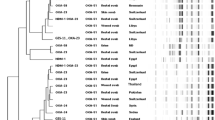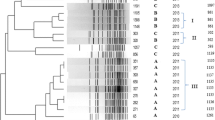Abstract
Four patients colonized/infected with carbapenem-resistant strains ofAcinetobacter baumannii are described. The first patient had a decubitus ulcer infection and had been on intravenous imipenem for 50 days. Two other patients, from whomAcinetobacter baumannii was isolated from urine, were hospitalized in the same ward as the first patient. The fourth patient had been mechanically ventilated in the intensive care unit for 4 month and had nosocomial pneumonia. He had been on intravenous meropenem for 1 month. Minimum inhibitory concentrations (MICs) of imipenem (128 mg/l) and meropenem (>128 mg/l) were the same for the isolates from the first three patients, and all of these isolates had the same repetitive extragenic palindromic polymerase chain reaction (rep-PCR) pattern. The MICs of carbapenems were lower for patient 4's isolate, which also had a different rep-PCR pattern. Beta-lactamases that hydrolyzed imipenem were detected in all four isolates; isoelectric points were 8.6−7.7 in the first three isolates and 6.8−7 in the fourth isolate.
Similar content being viewed by others
References
Bergogne-Bérézin E, Joly-Guillou ML: Hospital infection withAcinetobacter spp.: an increasing problem. Journal of Hospital Infection (1991) 18, Supplement A:250–255.
Bergogne-Bérézin E:Acinetobacter spp. as nosocomial pathogens: microbiological, clinical, and epidemiological features. Clinical Microbiology Reviews (1996) 9:148–165.
Vandeubroucke-Grauls CMJE, Kerver AJH, Rommes JH, Jansen R, den Dekker C, Verhaef J: EndemicAcinetobacter strains in a surgical intensive care unit: mechanical ventilators as reservoir. European Journal of Clinical Microbiology & Infectious Diseases (1988) 7:485–489.
Bergogne-Bérézin E: The increasing of outbreaks ofAcinetobacter spp: the need for control and new agents. Journal of Hospital Infection (1995) 30:441–452.
García-Arata MI, Alarcón T, López-Brea M: Emergence of isolates ofAcinetobacter calcoaceticus-Acinetobacter baumannii complex in a Spanish hospital over a five-year period. European Journal of Clinical Microbiology & Infectious Diseases (1996) 15:512–515.
Okpara AU, Maswoswe JJ: Emergence of multidrug-resistant isolates ofAcinetobacter baumannii. American Journal of Hospital Pharmacology (1994) 51:2671–2675.
Tankovic J, Legrand P, De Gatines G, Chemeneau V, Brun-Buisson C, Duval J: Characterization of a hospital outbreak of imipenem-resistantAcinetobacter baumannii by phenotypic and genotypic methods. Journal of Clinical Microbiology (1994) 32:2677–2681.
Urban C, Go E, Mariano U, Berger BJ, Avraham I, Rubin D, Rehal JJ: Effect of sulbactam on infections caused by imipenem-resistantAcinetobacter calcoaceticus biotype anitratus. Journal of Infectious Diseases (1993) 167:448–451.
Livermore DM: Acquired carbapenemases. Journal of Antimicrobial Chemotherapy (1997) 39:673–676.
Perez AN, Bonet IG, Robledo EH, Abascal RDS, Plous CV: Metallo-β-lactamases inAcinetobacter calcoaceticus? Medical Science Research (1996) 24:315–317.
Towner KJ, Chopade BA: Biotyping ofAcinetobacter calcoaceticus using the API 20NE system. Journal of Hospital Infection (1987) 10:145–151.
Bouvet PJM, Grimont PAD: Identification and biotyping of clinical isolates ofAcinetobacter. Annals Institute Pasteur/Microbiology (1987) 138:569–578.
Vila J, Marcos MA, Jimenez de Anta MT: A comparative study of different PCR-based DNA fingerprinting techniques for typing of theAcinetobacter calcoaceticus-Acinetobacter baumannii complex. Journal of Medical Microbiology (1996) 44:482–489.
National Committee for Clinical Laboratory Standards: Methods for dilution antimicrobial susceptibility tests for bacteria that grow aerobically. Approved standard M 7-A4. NCCLS, Villanova, PA (1997).
Joly-Guillou ML, Vallé E, Bergogne-Bérézin E, Philippon A: Distribution of beta-lactamases and phenotype analysis in clinical strains ofAcinetobacter calcoaceticus. Journal of Antimicrobial Chemotherapy (1988) 22:597–604.
Perilli M, Felici A, Oratore A, Corneglie G, Bonfligio G, Rossolini GM, Amicosante G: Characterization of the chromosomal cephalosporinases produced byAcinetobacter lwoffii andAcinetobacter baumannii clinical isolates. Antimicrobial Agents and Chemotherapy (1996) 40:715–729.
Paton R, Miles RS, Hood J, Amyes SGB: ARI-1:β-lactamase mediated imipenem resistance inAcinetobacter baumannii. International Journal of Antimicrobial Agents (1993) 2:81–88.
Patterson JE, Vecchio J, Panthelick E, Ferol P, Mezon D, Zervos MJ, Hierholzer WJ: Association of contaminated gloves with transmission ofAcinetobacter calcoaceticus var.anitratus in an intensive care unit. American Journal of Medicine (1991) 91:479–483.
Kaul R, Burt J, Cork L, Dedier H, Garcia M, Kennedy C, Brunton J, Krajden M, Conly J: Investigation of a multiyear multiple critical care unit outbreak due to a relatively drugsensitiveAcinetobacter baumannii: risk factors and attributable mortality. Journal of Infectious Diseases (1996) 174:1279–1287.
Sherertz RJ, Sullivan ML: An outbreak of infections withAcinetobacter calcoaceticus in burn patients: contamination of patients' mattresses. Journal of Infectious Diseases (1985) 151:252–258.
Scarpelle EG, Wenger AR, Armitige L: Nosocomial outbreak caused by a multiresistant clone ofAcinetobacter baumannii: results of the case-control and molecular epidemiologic investigations. Infection Control and Hospital Epidemiology (1995) 16:92–97.
Peacock JE, Sarrell L, Sottile FD: Nosocomial respiratory tract colonization and infection with aminoglycoside-resistantA. calcoaceticus var.anitratus: epidemiologic characteristics and clinical significance. Infection Control and Hospital Epidemiology (1988) 9:302–308.
Go SE, Urban J, Kresmith B, Cisner W, Mariano N, Mosinka Snipes K, Rahal JJ: Clinical and molecular epidemiology ofAcinetobacter only sensitive to polimyxin B and sulbactam. Lancet (1991) 37:405–412.
Gehrlein M, Leying H, Cullman W, Wendt S: Imipenem resistance inAcinetobacter baumannii is due to altered penicillin binding proteins. Chemotherapy (1991) 37:405–412.
Obara M, Nakae T: Mechanisms of resistance toβ-lactam antibiotics inAcinetobacter calcoaceticus. Journal of Antimicrobial Chemotherapy (1991) 28:791–800.
Scaife W, Young HK, Paton R, Amyes S: Transferable imipenem-resistance inAcinetobacter species from a clinical source. Journal of Antimicrobial Chemotherapy (1995) 36:585–587.
Author information
Authors and Affiliations
Rights and permissions
About this article
Cite this article
López-Hernández, S., Alarcón, T. & López-Brea, M. Carbapenem resistance mediated by Beta-lactamases in clinical isolates ofAcinetobacter baumannii in Spain. Eur. J. Clin. Microbiol. Infect. Dis. 17, 282–285 (1998). https://doi.org/10.1007/BF01699988
Issue Date:
DOI: https://doi.org/10.1007/BF01699988




